| SEPTEMBER 2019 |
|
5 shows in T˘ky˘ (Kabukiza, National Theatre, NHK Hall), 1 show in Ky˘to (Minamiza), 1 in Nagoya (NTK Hall), 1 in ďsaka (National Bunraku Theatre), 1 in Musashino (Musashino Shimin Kaikan) and 1 tour (Western Provinces)!
|
| Kabukiza (T˘ky˘) |  |
| Dates | 1 ~ 25 September 2019 Shűzan Matsuri Kugatsu ďkabuki Shűzan's Festival September Grand Kabuki |
| MatinÚe | |
| Evening | |
| Casting |
Living National Treasure Nakamura Kichiemon, Living National Treasure Kataoka Nizaemon, Living National Treasure Nakamura T˘z˘, Matsumoto K˘shir˘, Nakamura Jakuemon, Onoe Kikunosuke, Nakamura Baigyoku, Nakamura Kaishun, Kataoka Takatar˘, Nakamura Fukusuke, Nakamura Kinnosuke, Onoe Sh˘roku, Nakamura Karoku, Nakamura Matagor˘, Nakamura Kotar˘, Nakamura Baishi, Band˘ Kamez˘, Matsumoto Kingo, Nakamura Matsue, Sawamura S˘nosuke, Nakamura Yonekichi, Nakamura Kash˘, Nakamura Tanenosuke, Nakamura Mantar˘, ďtani Hirotar˘, ďtani Hiromatsu, Nakamura Takanosuke, Kataoka Sennosuke, Onoe Ushinosuke, Kataoka Matsunosuke, Arashi Kitsusabur˘, Nakamura Kichinoj˘, Ogawa S˘ma |
| Comments |
The 12th edition in T˘ky˘ of a special program called "Shűzan Matsuri" (the festival of Shűzan) is staged at the Kabukiza to commemorate the great actor Nakamura Kichiemon I, whose's haimy˘ was Shűzan. "Numazu" and "Matsuura no Taiko" are staged to commemorate the 100th anniversary of the passing away of Nakamura Karoku III (who died the 17th of May 1919). There is also the omemie of Nakamura Kash˘'s son Ogawa S˘ma.
|
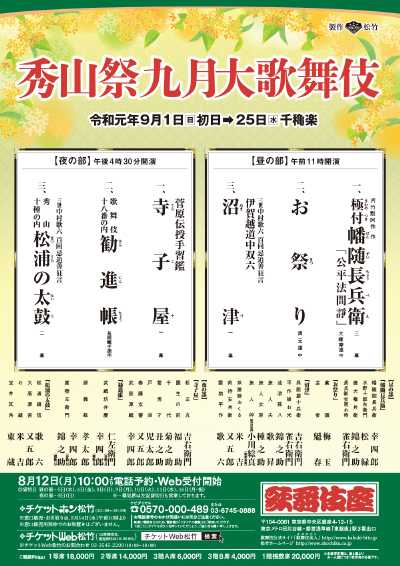 |
|
|||
| Dates | 2 ~ 26 September 2019 Kugatsu Hanagata Kabuki September Young Actors Kabuki |
||
| Program | |||
| Casting |
Nakamura Shichinosuke, Kataoka Ainosuke, Ichikawa Chűsha, Nakamura Kazutar˘, Kataoka Kamez˘, Ichimura Manjir˘, Nakamura Kamenoj˘ |
||
| Comments |
T˘shi ky˘gen production of Tsuruya Nanboku IV's masterpiece "Yotsuya Kaidan" in Ky˘to at the Minamiza!
|
||
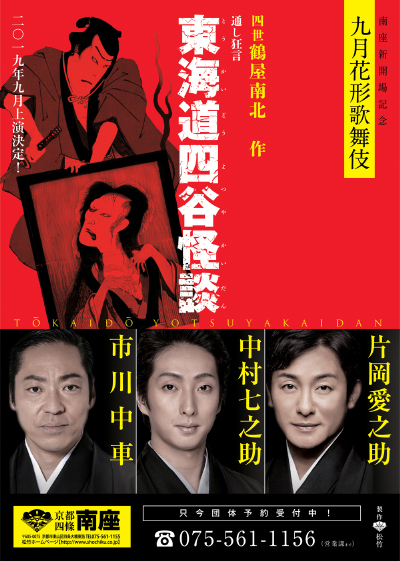 |
| Kabuki Tour in the western provinces | |
| Dates | 31 August ~ 25 September 2019 |
| Program | |
| Casting |
Nakamura Ganjir˘, Nakamura Senjaku, Onoe Matsuya, Kawarasaki Gonjűr˘, Ichikawa Komaz˘, Kamimura Kichiya, Nakamura Jűjir˘, Nakamura Toranosuke, Kamimura Kichitar˘ |
| Comments |
The usual September Grand Kabuki Tour in the western provinces.
|
| National Theatre (T˘ky˘) |
| Dates | 1 ~ 2 September 2019 Ken no Kai |
| Program |
Benten Musume Meo no Shiranami
|
| Casting |
Onoe Ukon, Ichikawa Danz˘, Band˘ Hikosabur˘, Kataoka Ichiz˘, Ichikawa Kudanji, Arashi Kitsusabur˘, Nakamura Umemaru, Band˘ Kamesabur˘ |
| Comments |
5th edition of the Ken no Kai, which stars Onoe Kikugor˘ VI's great-grandson Onoe Ukon. Ken no Kai literally means 'Ken's Association' with Ken being the first ideogram in Onoe Ukon's real first name Kensuke. |
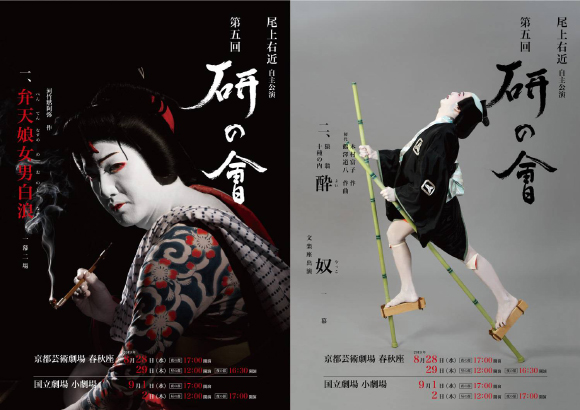 |
| Dates | 28 ~ 29 September 2019 Sh˘ no Kai |
| Program | |
| Comments |
6th edition of the Sh˘ no Kai, a gala program which stars Nakamura Tomijűr˘ V's son Nakamura Takanosuke. This year, it celebrates the 300th anniversary of the birth of Nakamura Tomijűr˘ I. The dance master Fujima Kanjűr˘ VIII and Nakamura Takanosuke's sister Watanabe Aiko also perform. |
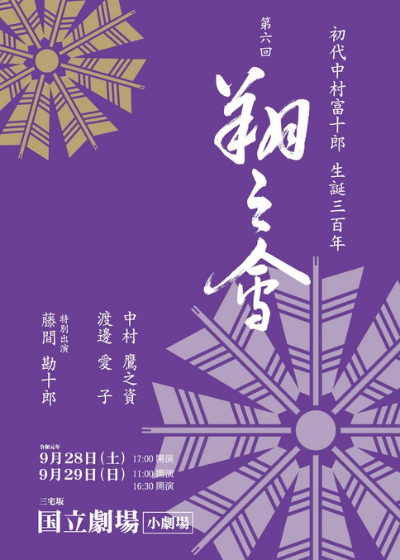 |
| NTK Hall (Nagoya) | |
| Dates | 16 ~ 17 September 2019 |
| Program |
Nezumi Koz˘ Jirokichi |
| Casting |
Fujikawa Yanosuke, Kitazawa Kanami, Tadamura Shin'ya, Matsunami Kihachir˘, Hayase Einoj˘, Nakajima K˘tar˘, Yamamoto Harumi, Tamaura Yűnosuke, Yamazaki Tatsusabur˘, Matsuura Kainosuke |
| Comments |
Revival in Nagoya at the NTK Hall of Mayama Seika's drama "Nezumi Koz˘ Jirokichi" based on the story of the thief Nakamura Jirokichi, commonly called Nezumi Koz˘. |
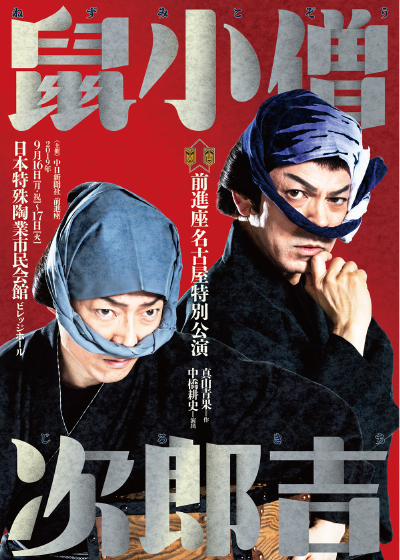 |
| National Bunraku Theatre (ďsaka) |
| Dates | 20 ~ 27 September 2019 |
| Program |
Nezumi Koz˘ Jirokichi |
| Casting |
Fujikawa Yanosuke, Kitazawa Kanami, Tadamura Shin'ya, Matsunami Kihachir˘, Hayase Einoj˘, Nakajima K˘tar˘, Yamamoto Harumi, Tamaura Yűnosuke, Yamazaki Tatsusabur˘, Matsuura Kainosuke |
| Comments |
Revival in ďsaka at the National Bunraku Theatre of Mayama Seika's drama "Nezumi Koz˘ Jirokichi" based on the story of the thief Nakamura Jirokichi, commonly called Nezumi Koz˘. |
 |
| Musashino Shimin Kaikan (Musashino) | |
| Dates | 30 September 2019 |
| Program |
Nezumi Koz˘ Jirokichi |
| Casting |
Fujikawa Yanosuke, Kitazawa Kanami, Tadamura Shin'ya, Matsunami Kihachir˘, Hayase Einoj˘, Nakajima K˘tar˘, Yamamoto Harumi, Tamaura Yűnosuke, Yamazaki Tatsusabur˘, Matsuura Kainosuke |
| Comments |
Revival in Musashino at the Musashino Shimin Kaikan (Musashino Civic Hall) of Mayama Seika's drama "Nezumi Koz˘ Jirokichi" based on the story of the thief Nakamura Jirokichi, commonly called Nezumi Koz˘. |
 |
| NHK Hall (T˘ky˘) | |
| Dates | 28 September 2019 (Koten Gein˘ Kansh˘ Kai) |
| Program | |
| Casting |
Onoe Kikunosuke, Nakamura Tokiz˘, Nakamura Baishi, Nakamura Mantar˘, Onoe Kikuichir˘ |
| Comments |
46th edition of Koten Gein˘ Kansh˘ Kai (literally the "Classics Entertainment Appreciation Association"), a yearly performance produced by the National TV network NHK. The program includes traditional music, one ky˘gen and one Kabuki drama.
|
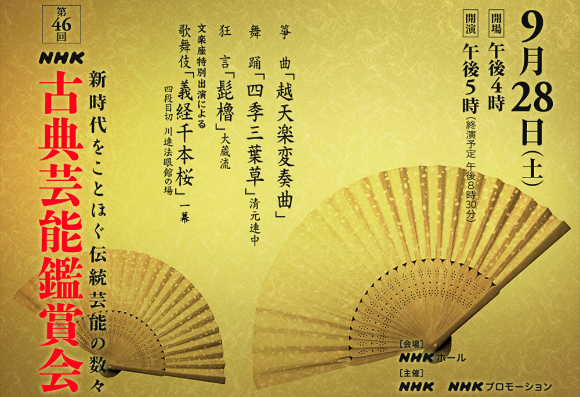 |
|
|
| Contact | Main | Top | Updates | Actors | Plays | Playwrights | Programs | Links | FAQ | Glossary | Chronology | Illustrations | Prints | Characters | Derivatives | Theaters | Coming soon | News |